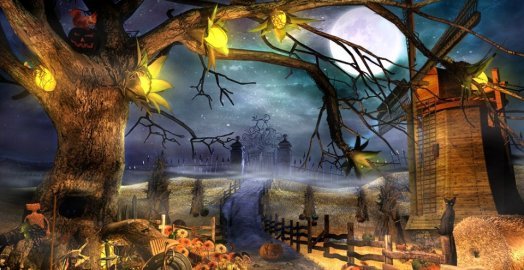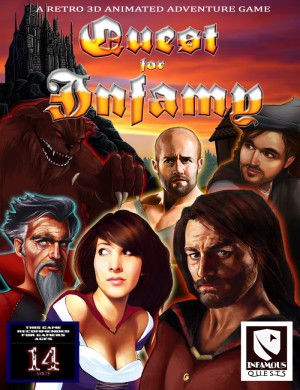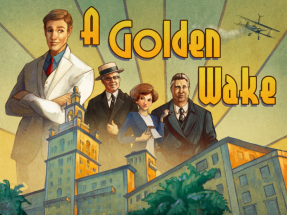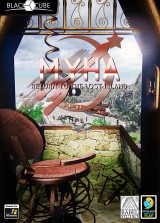Review for Evil Pumpkin: The Lost Halloween

Any child’s story about Halloween would surely involve a lot of candy, sneaking out of the house, and a space octopus… Well, maybe not that last part, but you’ll find a bevy of strange characters in the delightfully illustrated world of Evil Pumpkin: The Lost Halloween. This trippy journey, rendered in beautiful detail, is about a young boy who’s determined to find out why Halloween has deserted his sleepy town of Dern. You’ll meet the aforementioned octopus, a crazy orphanage mistress, and kids with pumpkins for heads (among many others) in this fairly lengthy casual mystery filled with a wide variety of fun if sometimes tricky puzzles, and purely optional hidden object scenes.
The story opens with the disapproving shadow of a father standing in a backlit doorway. He asks his son if he has seen a missing book. Of course he hasn’t seen it, the boy says, but we all know that of course he has. This is one precocious boy we’re dealing with, which we know from the overly formal (in a child-pretending-to-be-much-older-then-he-is way) journal entries he presents to us, like the one outlining his plans to steal his father’s book: “The complex architecture of my design includes so many variables that it might as well be considered infinite, yet I am giving it a go.”
And so this young boy (he is only ever identified as “Boy”) plots to sneak out of his house with the aid of the mysterious book, without garnering the attention of his strict father. Not only does the book tell the tale of why Dern is the only town that doesn’t celebrate Halloween, but it also appears to be enchanted. It challenges the boy to explore the story behind Halloween, and even allows him, through some strange discharge of magical energy mumbo jumbo, to speak to a wizened owl who suddenly appears at his bedroom window.
The entire tale is told from the point of view of the boy. This isn’t a thrills-down-your-spine Halloween chiller; it’s instead a tale of adventure that begins with “running away from home and ends with lunchtime.” This perspective – that of a very young boy with a slim grasp of what is unfolding around him – makes this more of a cute and nonthreatening seasonal story. In lieu of jump scares and gore, you’ll find plenty of beautifully rendered scenes and a focus on exploring the child’s rather odd imagination.
Upon escaping the house, you will meet a variety of characters. The adults always have errands for you to perform before providing helpful information or items. Take the long-faced old bartender, Lemuel Barnabas. He’s not about to assist you before you help him unscramble his dinner menu. In a welcome touch, the people you meet have little unexpected details to flesh out their personalities. Though Lemuel is crotchety and a bit demanding as he listlessly stands behind his dirty bar counter, you soon discover that he also has a penchant for dancing to an old gramophone when no one is around. Barnabas’s wife works next door at a toy store. She too seems to have a musical bent, and she’s just dying to get a chance to practice her singing chops every chance she gets.
Because the characters are all voiced, you will get a chance to hear Mrs. Barnabas sing. Minor key music plays loudly in the background, and there is a fair amount of voice acting in the game. Most of it is done by the protagonist, whose actor is clearly someone older trying to sound like a small child. The strangely voiced owl sounds a bit like Kermit the frog with a sore throat. This owl is an odd one in his own right, croaking out that he’d “love to stay and chat, but the abyss and I have ourselves a staring competition.” When you enter into a dialogue, you will see 2D images of the characters against a black screen with subtitles printing as they talk. The ambient sounds are a nice touch, with the occasional squeaking of mice or the crunch of shoes walking across gravel adding a bit of depth to the environment.
As you travel further away from home and deeper into this odd world, the characters you meet become even stranger, including Ms. Cringeworth, who runs an old ghost-ridden orphanage, and a group of boys walking around with pumpkins covering their heads. To get to the pumpkinheads and this increasingly colorful cast, naturally you must explore the world around you. Fortunately, that’s a pleasure to do, as another of the game’s strengths is the wonderfully quirky artwork. Many scenes use a suitably Halloweeny palette, with backdrops the color of a bruise splashed with muted smears of orange. The silvery light of a large, swollen moon adds a muted glow to everything. The soft colors and lighting are complemented by a lovely Art Nouveau aesthetic, with graceful curlicues shaping the metal arms of storefront awnings and the warm curves of wooden doors.
While Evil Pumpkin features a traditional slideshow presentation, the artists have done a wonderful job of packing each beautiful scene with bizarre but fun details and some ambient animations. A small graveyard rests in the center of a model train set, sitting beneath the glow of stars and suns thrown on the ceiling by a cutout lampshade in the toy store. And though the boy lives in a town that doesn’t celebrate Halloween, the holiday must somehow be in his blood, as his bed sheets are covered in pumpkins and bats. He also owns a small headless horseman statue with a cape that billows softly in a nonexistent breeze. In fact, Halloween oddities infuse every scene, from the iron bars of a gate forming the shape of a pumpkin, to pumpkin light shades throwing orange light in a nightmare version of the boy’s room.
The environment isn’t just packed with details to look at, as there is some nice interactivity: Click on a small ball and it wobbles a bit before a description pops up telling you that you’ve got no time to play now. Click on a stuffed octopus, and you’ll discover that this used to be the boy’s favorite toy, Benjamin. Browse through a wine rack and see things like a Marilyn Merlot or a bookshelf that stocks such classics as "Donkey Hot: The Driving Comedy".
These details fill out a lite but traditional point-and-click adventure, which not only gives you the option to play on three difficulty levels, but also allows you to play the game with or without hidden object scenes. For this review, I played through without the hidden object scenes and on the easiest level, where you are able to skip most of the puzzles as well as click on a hint button to show you where you should go next should you get lost. You also have a journal that provides you with story notes, which you should pay attention to as it has information that will both help you out with some puzzles and provide a quest log. I didn’t find the quest log all that helpful, however, as it was a very long list of quests and quest names that didn’t always seem to match with what I was currently doing.
The puzzles are a pleasant mix of inventory and logic challenges, with a good measure of small minigames thrown in. The inventory obstacles aren’t just your typical find-keys-to-locks searches, although there are fair number of those thrown in too. You’ll be gathering up a variety of strange objects, as small boys are wont to do, including rotten sandwiches, dentures, and hamsters. You can manipulate certain items after you’ve obtained them. Once you click an object in your inventory, you can click on different parts of it to remove pieces or put other pieces together. And don’t forget to revisit areas. Places that you may have fully explored will sometimes gain new hotspots as you progress in the story.
You’ll also discover items called “Gizwork” pieces. These objects, like a pencil and scissors, can be used multiple times throughout the game. Each time you use them, they will “level up,” meaning you can use them for more tasks, though I had trouble determining when to use them at times or what the leveling up actually had to do with making them more useful. (They still seemed to do the same things, such as cut and write.) I found myself stumped when I tried to use, say, the scissors on logical things, only to discover that I couldn’t. I wasn’t always sure if I couldn’t use them because they were the wrong object or because as a Gizwork piece it simply wasn’t leveled up enough. Another frustration is that sometimes you’re required to complete an interaction multiple times for something to happen. When I performed one action and nothing happened, I thought I was still missing an inventory item. After a frustrating search only to pull up nothing new, I resorted to a walkthrough hint that indicated I had just not done the same interaction enough times.
In between searching for inventory items, you’ll also be solving logic puzzles. There are old familiars here, like a variety of sliders (ugh) and jigsaw puzzles. But the sheer number of puzzles guarantees that you’ll play through a nice spectrum in terms of originality and difficulty. Examples include a clock puzzle that has you moving Roman numerals around the clock face to discover the correct pattern, and another that has you moving items between two tables that might belong to a priest on one table and a lady on the other table.
Many of the puzzles have nice feedback systems telling you when you’re on the right track, such as a picture puzzle whose correctly-placed pieces lock in so that no further movement is allowed. However, the “Info” button for puzzles pulls up a poem rather than a straightforward explanation of what to do. (An example: “My dad often used to say: ‘Where there’s a gear, there’s a way.’ I’d propose a curious bait: How many ways when gears are eight?”) At times these poems led to nothing but confusion for me, being much too cute and not nearly informative enough. I found this to be the case mostly for the minigames. These usually involve the use of inventory items, but were largely trial and error for me to figure out how to even get started.
Some of the minigames require precise aim and timing: one task that had me throwing objects at clothes on a clothesline took me at least ten tries to complete. Another of these minigame-type sequences had me keeping a tire steady as it rolled down a road. If those aren’t difficult enough, there are a few minigames that test your fast-flexes as well, including a lock and tumbler puzzle. Though there is a skip button for some of the puzzles, the refill timer is maddeningly slow even on the easiest difficulty level, and you are simply unable to skip some of the minigames, which could be a game-stopper for some.
Despite these frustrations, though, I found the vast majority of puzzles to be enjoyable. One involves a twist on a typical maze that had me finding patterns and choosing between such directions on a sign post as “Nowhere” and “Somewhere” and “There.” In one lock puzzle, rather than have you search high and low for a key, you participate in a fun 20 question-type puzzle to find the key. Some puzzles even require trivia from outside the game world, such as the colors included in different country flags. One of the larger puzzle set pieces toward the end of the game involves the pumpkinheaded boys. They are so lost that they don’t even know where they live, leading to a variety of puzzles designed to help figure out which one lives in which house. These particular puzzles are long, multilayered at times, and fun.
As with Halloween loot, the designers clearly believed that when it comes to gameplay you can’t have too much of a good thing. During the main quest, there is also a larger meta-scavenger hunt to find pieces of candy hidden in each of the scenes (though they are very small and difficult to see at times). Find enough candy and you can buy Halloween decorations to decorate a spooky yard scene.
Of course, you aren’t just puzzle-solving here. You are on a mission to find out why Halloween has left Dern, but there was nothing to really compel me to learn more about the town and its odd relation to Halloween. As I made my way through the six chapters that played out close to seven hours of gameplay, the story got loopier and loopier. It’s an interesting take on a Halloween tale, told through the eyes of a wildly imaginative young boy, but it frankly didn’t make that much sense at the best of times – and all sense flew out the window when I met up with the space octopus.
Having said that, this is a wonderfully beautiful game to play through, with a lot of interactivity and fun details. And the puzzles… my goodness, the puzzles. The variety and scope will have puzzle lovers thinking they hit the trick-or-treat mother lode – mostly filled with candy, though with the odd apple and toothbrush the curmudgeons down the street always hand out sprinkled into the mix. If you’re looking for a trippy bit of puzzling Halloween fun, and don’t mind a few frustrating timed sequences amidst a story that doesn’t bother much with coherence, you’ll find your fill in Evil Pumpkin: The Lost Halloween.
Our Verdict:
Evil Pumpkin’s tricks and treats are about evenly doled out in this quirky casual entry in a wonderfully imaginative Halloween world.



_capsule_fog__medium.png)

























